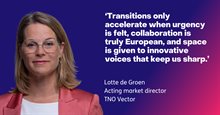Want to know more?
You can read the entire report: ‘Reflection on the provincial
Multi-Year Programmes for Energy and Climate
Infrastructure 1.0’ (in Dutch).
Reflection on pMIEKs 1.0: A New Look at Energy Infrastructure
The ‘Reflection on provincial Multi-Year Programmes for Energy and Climate Infrastructure 1.0’ is based on a large number of interviews with stakeholders and on the pMIEKs delivered. The aim of the Reflection is to draw lessons from this first version of the pMIEKs, as the process is new and the next round started in autumn 2023.
‘Energy infrastructure has never before been linked in this way to the local consideration of societal interests,’ explains Karlien Sambell, energy transition consultant at TNO Vector. ‘Alignment between spatial planning and energy is important, because energy infrastructure is necessary in places where we will want to live and work, and where companies will want to establish themselves in the future. An integrated approach enables you to make considerations and choices relating to society.’
‘You will face difficult issues. For example, do you prioritise a business park or start with new charging points and heat pumps in a residential area?’ – Karlien Sambell, energy transition consultant at TNO Vector
Valuable progression, though transparency could be better
Sambell says: ‘You then face difficult issues. For example, when expanding energy infrastructure, do you give priority to a business park that wants to become more sustainable or do you start with new charging points and heat pumps in a residential area? This is a governance issue and it calls for a different way of making decisions. Better collaboration between the provinces, municipalities, and grid operators is required and you need to bring together different policy areas, including spatial planning and energy. Public authorities and grid operators also need to be more knowledgeable about each other’s fields and processes.’
The Reflection shows that public authorities and grid operators have already come a long way in this new approach. Rebecca Dowling, energy transition consultant at TNO Vector, says: ‘A lot has already happened in this first round. That’s impressive, given the huge time pressure and the sometimes limited number of staff that drafted them. Our main conclusion is that valuable steps have been taken. At the same time, we see that prioritisation is sometimes not very transparent, and that processes are not equally as good everywhere.’
Differences in approach between provinces
The major differences between the processes in the various provinces are striking. Dowling comments: ‘Two had already completed their energy vision, another step in the process of integrated programming. This provides guidance for the short, medium, and long term. A few provinces already had an ‘assessment framework’ that enabled them to score developments on factors such as cost, efficiency, space, and community support. On that basis, you can properly justify choices. For example: Are you going to heat a residential area with a heat grid or with individual solutions such as a heat pump?’
‘But most provinces didn’t yet have an energy vision or assessment framework ready and they were forced to take a pragmatic approach because of time constraints. For example, they took the grid operators’ plans and stated in them that solving demand bottlenecks takes priority over supply bottlenecks.’
That approach usually led to a reasonably good understanding of provincial power grids. ‘But that’s less true for heat and hydrogen grids,’ Sambell adds. ‘What’s more, these assessment frameworks work less well for national grids, which facilitate many more initiatives than regional grids. This requires the closer involvement of national grid operators Tennet and Gasunie. It’s also important to plan beyond 2030. Indeed, that’s where the biggest gains can be made in accelerating the construction of energy infrastructure.’
Reflection as a source for future pMIEKs
The Reflection provides valuable lessons for the next round of pMIEKs, to be completed in two years’ time, in early February 2026. Rebecca Dowling says: ‘The Reflection contains some good examples of how different provinces set up their pMIEKs. For example, how they collected data or how the assessment framework was applied. But provinces can learn from one another’s good examples.
We also see that the exchange of basic data, on supply and demand with regard to electricity or heat, for example, could be better and more uniform. It should be easy for provinces, grid operators, and municipalities to share those data with each other. Because confidential data are sometimes involved, we can perhaps take a cue from how companies in an energy cluster now want to organise this.’
‘In the next round of pMIEKs, it’s also important to take a more comprehensive look at long-term energy system development,’ notes co-author Robert Koelemeijer (PBL). ‘In the pMIEKs 1.0, there was a strong focus on electricity and on the relatively short term, partly because of acute grid congestion. By looking more broadly at opportunities to use heat, renewable gases, and flexibility options, we can reduce pressure on the electricity grid. Opportunities to do so will have to be identified in the energy visions.’
pMIEK prioritisation requires broader collaboration for acceleration
Sambell says: ‘Accelerating the creation of energy infrastructure requires more than simply drafting a pMIEK. Prioritisation alone does not automatically lead to acceleration.
For example, an overarching project approach by governments, grid operators, and companies would help enormously in this regard. With greater understanding of each other’s decision-making, processes could run in parallel and parties would not have to wait for each other as much. The process of constructing a substation, for example, would take a lot less time.’





